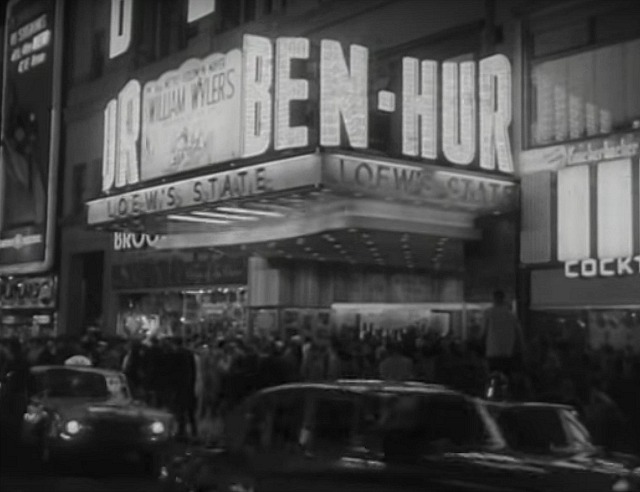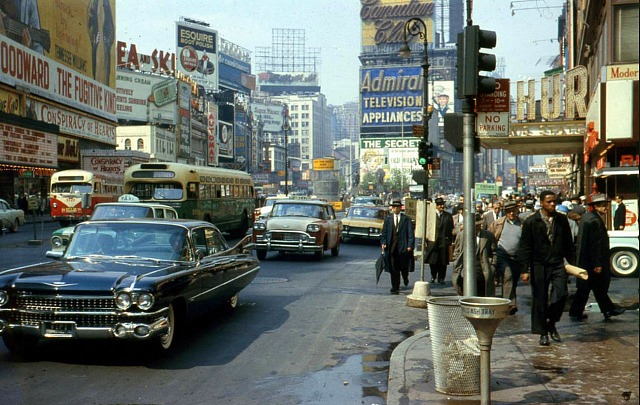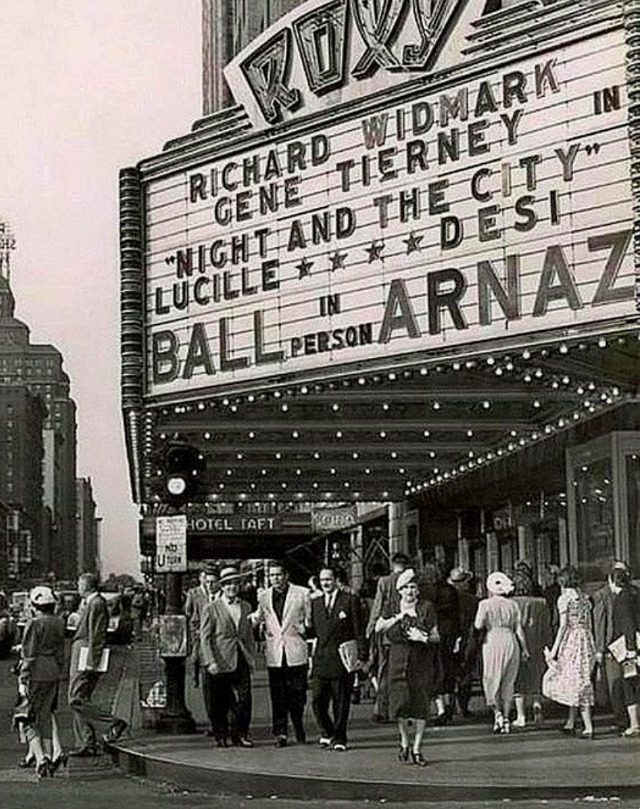Lenny Abramson‘s The Little Stranger (Focus Features, 8.31) feels like a revisiting of Atonement with an eerie supernatural undercurrent. Based on the same-titled period novel (1940s) by Sarah Waters. Any way you slice it Domhnall Gleeson doesn’t put butts in seats. Ruth Wilson, Will Poulter, Charlotte Rampling.
Daily
DeNiro F-Bombs, Parkland Students Sing Out
The CBS powers-that-be bleeped out what Robert De Niro said tonight at the Tonys: “Fuck Trump.” But Australia heard it, and then Twitter passed it along.
Robert De Niro's popularity is suddenly rising in Canada. pic.twitter.com/30LPxiWg7f #TonyAwards
— David Beard (@dabeard) June 11, 2018
Criterion Teal Monster Strikes Again
What’s up with Criterion’s penchant for teal-tinting? Whatever’s blue, they’ll turn it into teal. Six weeks ago the ludicrous teal-tinting of Criterion’s Midnight Cowboy Bluray (“Green Cowboy…Eegadz“, “Criterion’s Teal Tint Insanity“) was revealed. Now we have the teal-tinting of Ron Shelton‘s Bull Durham to contend with by way of Criterion’s forthcoming Bluray. The DVD Beaver frame captures tell the tale. The question is “why?” Teal-binging makes no sense. It’s absolutely deranged.
“Criterion’s image has a bad case of the ‘teals’,” according to DVD Beaver’s Gary W. Tooze. “Blue jackets have moved to teal…the ‘teal’ controversy will resume.”
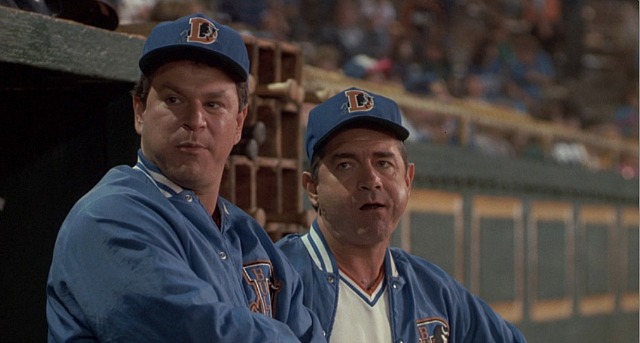
Natural blue jackets — the way they’ve always looked.
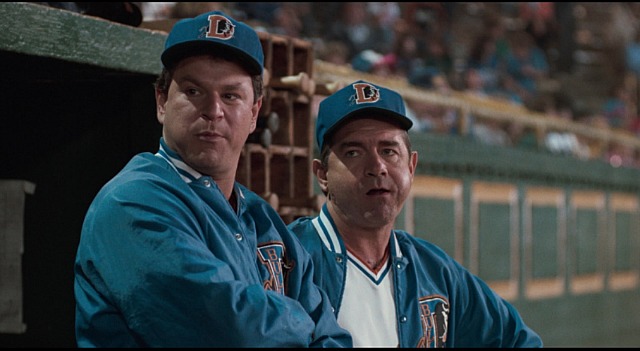
Criterion’s teal dye job.
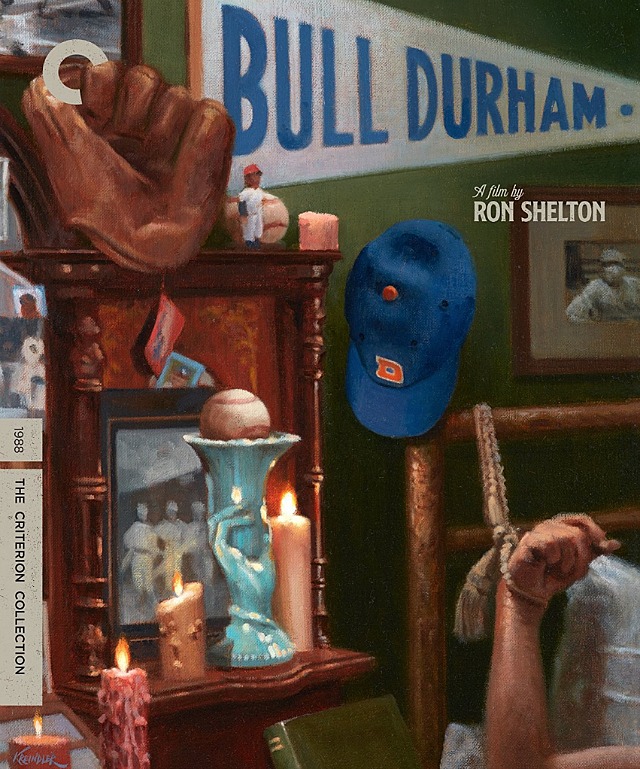
Some Have Gone There
Anthony Bourdain‘s suicide was being discussed this morning on a certain Facebook thread, and I chimed in with the following: “I don’t think I’d have the courage to commit suicide. Especially by hanging myself with a necktie…good God. I’m too terrified of the nothingness of death, the infinite flatline, the eternal void, the sleep from which there’s no waking. Under the shroud of death there’s no pain, burdens or anxieties, of course, but I gladly accept them on a daily basis as the price for being alive. We all have a rendezvous with death, but I want to live forever. No kidding. I could be suffering through the worst day of my life, and I still couldn’t off myself.”
Concisely stated by Woody Allen: “I don’t want to live on through my work — I want to live on by not dying.”
Animal Ghoul Fare vs. Dramatic Ice-Blood
After loving Hereditary during last January’s Sundance Film Festival, Variety ‘s Owen Gleiberman caught it a second time this weekend after hearing that low-rent horror fans were sneering and laughing and give it a shitty CinemaScore grade. Here’s his report:
“Why are there so many people turning on Hereditary who would be all too happy to sit through the limb-severing, soundtrack-gonging, ghost-face-in-the-mirror megaplex horror implement of the week? The reason they’re turning on it, of course, is that it’s not the horror implement of the week.”

Once again, he concluded, we’re witnessing “a nearly epistemological divide in the moviegoing audience, a kind of blue state/red state schism.
“Horror films now require a kinesthetic element of funhouse sensation to engage a wide audience. A Quiet Place is a good example. True to its title, it’s a quiet and subtle movie — except for when it’s not, when aliens with jaws the size of bulldozer shovels are tearing away at anything that dares to make a sound.
“These days, the horror films that become mainstream hits tend to be so sensational, even debased, that they’re like ritualized celebrations of our inhumanity. At slasher movies, people view the killers as rock stars of mayhem; at paranormal thrillers, ghosts go bump, crash, and boom in the night; at torture porn, the torture is the star — the ‘characters’ are just fresh meat. And almost any tale of the supernatural turns into a relentless carnival of Jack-in-the-box devils.”
Teutonic Chanteuse
The basic import of Susanna Nicchiarelli‘s Nico, 1988 (Magnolia, 7.4) is that the legendary ice-cool Nico — deep-voiced, stone-faced, Teutonic doom-chanter — was a greater artist in her heroin-habit decline period (late ’70s to late ’80s) than she was in her breakout period (mid ’60s to early ’70s). And that’s fine — a valid analysis of her songwriting and performing career.
But the film itself is slow, irksome, repetitive, sometimes vague and too often dull. Nicchiarelli makes her points, but the beat-by-beat watching of this 93-minute film is mostly unsatisfying. To me anyway. I checked my watch four or five times.
Everything I’ve always loved about Nico, musically-speaking, was the stuff she was unhappy with. She said over and over that her true musical identity and vision came into being only after her late ’60s Velvet Underground phase (“Femme Fatale”, “All Tomorrow’s Parties”, “I’ll Be Your Mirror”) and after “Chelsea Girl“, which she hated the arrangements for.

Heroin-habit Nico in 1985.
So fine — Nico only came into her own when she started writing and performing her own gloom-rock material. I’m sure that was true. Except I’ve never listened to her gothy downswirl stuff, but I love “Chelsea Girl” and the 1967 banana album. Does that make me a serf or an asshole? I don’t think so.
Last September the Venice Film Festival elite creamed over Nico, 1988, but what else is new? You can’t trust critics when it comes to personal-vision indie cinema because they almost always give films like Nico, 1988 a pass, in part because they don’t want to be the naysaying stand-out. Maybe you can’t trust Hollywood Elsewhere either, but at least I deal straight cards.
Nico, 1988 is more into moods and atmospheres than particulars and specifics, and so the first thing you do after it’s over is go online to learn what actually happened on a chapter-by-chapter basis. That’s what I did after it ended. Only after I read everything about Nico’s declining years did the film start to come together in my head.
There’s a short scene in which Nico and her band visit the site of the Nazi rally grounds in Nuremberg but Nicchiarelli doesn’t want to identify the location because that would be tedious and unhip, and so it becomes a scene about the band visiting an old concrete stadium of some kind…who cares? The whole movie is like that. You can feel or least sense what’s happening, but Nicchiarelli often declines to fill in the blanks.
Nico’s life ended in ’88 while staying in Ibiza. She suffered a heart attack, fell off a bicycle, hit her head and died of a cerebral hemmorhage. Nichiarelli doesn’t depict this, of course, but you can’t help but wonder “well, why not?”
The film tells us that Nico’s son Ari (his father was Alain Delon) tried to kill himself while the band was on tour. Ari had a heroin problem of his own, but the film provides no hint as to why he would try to off himself, and there’s nothing online that mentions a suicide attempt. It just happens and then he recovers. So why did…forget it, sorry I asked.
Creepies
I don’t know how to precisely describe those moviegoers whose negative reactions to Ari Aster‘s Hereditary resulted in that now-infamous D-plus CinemaScore rating, but I do think that “dumb as rocks” is a fair term to use.
Despite this Hereditary will most likely earn $12 to $13 million for the weekend. Box Office Mojo‘s Brad Brevet wrote that perhaps the D-plus rating could be taken with a grain of salt as “CinemaScore always seems to behave a bit strangely when it comes to horror films.” He added that A24’s The Witch received a C-minus CinemaScore and yet enjoyed a solid box-office run.
Repeating once again: There are brilliant X-factor horror flicks — John Krasinski‘s A Quiet Place, Robert Eggers‘ The Witch, Jennifer Kent‘s The Babadook, Andy Muschietti‘s Mama and now Hereditary — and then there’s the pig trough of run-of-the-mill horror flicks. Do you want to hang back with the brutes or open yourself up to the New Insanity? Insensitive, all-but-clueless people tend to favor insensitive, all-but-clueless movies…sorry.
“I Don’t Know As I Like That”

HE’s 30 Greatest American Films: (1) The Treasure of the Sierra Madre, (2) Dr. Strangelove or: How I Learned To Stop Worrying and Love the Bomb, (3 & 4) The Godfather & The Godfather, Part II (5) The Graduate, (6) Election, (7) Zodiac, (8) Rushmore, (9) Pulp Fiction, (10) Some Like It Hot, (11) North By Northwest, (12) Notorious, (13) On The Waterfront, (14) Groundhog Day, (15) Goodfellas, (16) Out Of The Past, (17) Paths of Glory, (18) Psycho, (19) Raging Bull, (20) 2001: A Space Odyssey, (21) Manhattan, (22) Apocalypse Now, (23) Strangers on a Train, (24) East of Eden, (25) Bringing Up Baby, (26) The African Queen, (27) All About Eve, (28) The Wizard of Oz, (29) Zero Dark Thirty, (30) Only Angels Have Wings.
Late For Breakfast
Nobody is ever accidentally late to anything. If you’re not on time it means you didn’t want to be. You took your time because you felt like it. Period.
Ascending of Sylvia Trench
Eunice Gayson, the very first Bond girl in this history of the 56-year-old franchise, has passed at age 90. Gayson played Sylvia Trench, a hormonally inflamed brunette in her mid 30s, in three romantic scenes with original 007 Sean Connery — two in Dr. No (’62) and one in From Russia With Love (’63). Wikipage surprise: “Gayson’s voice in Dr. No and From Russia with Love was overdubbed by voice actress Nikki van der Zyl, as were the voices of nearly all the actresses appearing in the first two Bond films.”


